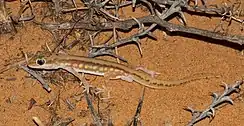Beaded gecko
The beaded gecko (Lucasium damaeum) is a gecko endemic to Australia.[1]
| Beaded gecko | |
|---|---|
 | |
| Female | |
| Scientific classification | |
| Domain: | Eukaryota |
| Kingdom: | Animalia |
| Phylum: | Chordata |
| Class: | Reptilia |
| Order: | Squamata |
| Family: | Diplodactylidae |
| Genus: | Lucasium |
| Species: | L. damaeum |
| Binomial name | |
| Lucasium damaeum Lucas & Frost, 1896 | |
Description

With only a few species of the genus Lucasium it is endemic to Australia.[2] The 7 cm long beaded gecko is reddish brown on top, with what looks like chains of beads surrounding the cream pale ridged vertebral strip, thus given the name of beaded gecko.[3][4] Single lines of pale blotches run down the side of its body with scattered smaller spots covering its dark brown limbs and surrounding body.[5] This gecko has a rounded snout rather than beaked (with the rostral connection to the nostril[6]), reddish brown in colour with a white or cream upper eyelid that is not able to cover, protect or clean the eye, rather the eye is covered in protective transparent scales.[7] To keep the eye clean they use their long flat tongue to wipe the eye. With relatively large eyes, the pupil is a thin vertical slit during the day and rounded and full in the dark.[8] The tail is a straight continuum of the body and the original tail has continuing patterns from the body down but will reproduce plain brown or spotted darker tails.[9] The toes of a beaded gecko are flat and unkinked without adhesive pads and usually whitish in colour. The feet of the beaded gecko are not suitable for climbing[10] The beaded gecko is nocturnal. Hiding through the day and coming out at night they travel large distances in search of food.[11]
Distribution
Beaded geckos are found in drier arid to semi-arid climate parts of mainland Australia in all states and the Northern Territory.[12]
Ecology and habitat
The beaded gecko is a terrestrial (ground-dwelling) animal that can be found in a variety of dry desert habitats within mainland Australia from the savannah woodlands to spinifex-covered sandhills.[13] During the day the gecko uses insects and spider holes for shelter before coming out at night to hunt in open areas. This swift-moving gecko covers large areas in search for food.[14]
Reproduction
The beaded gecko is oviparous, meaning it lays eggs rather than giving birth. Females are known to lay 2 eggs per clutch. Like most Australian reptiles, geckos have a breeding season which is from late September to December. Males have paired sex organs, each independent.[15]
Diet
Beaded geckos like most other small lizards feed mainly on insects. The jaw is surrounded with short fine teeth; however, prey is crushed by the gecko rather than chewed.[16]
Threats
Threats include loss of habitat, and feral predators like dogs, cats and foxes.[17]
References
- "Lucasium damaeum". The Reptile Database. Retrieved 11 November 2017.
- Doughty, P & Hutchinson, M.N. (2008). Records of western Australian museam. A new species of Lucasium (Squamata: Diplodactylidae) from the southern deserts of Western Australia and South Australia, 1(1), 95-106. Retrieved 4 June 2016, from https://www.researchgate.net/profile/Mark_Hutchinson4/publication/242182301_A_new_species_of_Lucasium_%28Squamata_Diplodactylidae%29_from_the_southern_deserts_of_Western_Australia_and_South_Australia/links/02e7e52deebc892f86000000.pdf
- Edgar, R.W. (1993). The Reptiles and Amphibians os Sount Australia . Australia: Hale H.M
- Hoser, R.T. (1989). Australian Reptiles and Frogs. Australia: Pierson & Co.
- Cogger, HG 2014 Reptiles and Amphibians of Australia, 7th ed. CSIRO Publishing, Collingwood, 311-311
- Wilson, S, & Swan, G. A 2013 Complete Guide to Reptiles of Australia, 4th ed. Now Holland Publishers 88-89
- Cogger, H. (1967). Geckos. (Ed), Australian Reptiles in colour` (pp. 20-28). Australia: Tressure Press Australia
- Cogger, H. (1967). Geckos. (Ed), Australian Reptiles in colour` (pp. 20-28). Australia: Tressure Press Australia
- Cogger, HG 2014 Reptiles and Amphibians of Australia, 7th ed. CSIRO Publishing, Collingwood, 311-311
- "Lucasium damaeum and others, Gawler Ranges, SA". Archived from the original on 17 March 2012. Retrieved 10 May 2011.
- Cogger, H. (1967). Geckos. (Ed), Australian Reptiles in colour` (pp. 20-28). Australia: Tressure Press Australia
- Cogger, HG 2014 Reptiles and Amphibians of Australia, 7th ed. CSIRO Publishing, Collingwood, 311-311
- Cogger, HG 2014 Reptiles and Amphibians of Australia, 7th ed. CSIRO Publishing, Collingwood, 311-311
- Wilson, S, & Swan, G. A 2013 Complete Guide to Reptiles of Australia, 4th ed. Now Holland Publishers 88-89
- Amazing amazon. (N.d). Beaded Gecko Care and Information Caring for Geckos. Retrieved 4 June 2016, from https://www.amazingamazon.com.au/beaded-gecko-care-housing-feeding-information
- Amazing amazon. (N.d). Beaded Gecko Care and Information Caring for Geckos. Retrieved 4 June 2016, from https://www.amazingamazon.com.au/beaded-gecko-care-housing-feeding-information
- Lucasium damaeum at the Australian Reptile Online Database. Last updated 2016-03-29 11:18:15.Retrieved from http://www.arod.com.au/arod/?species=Lucasium+damaeum on 4 June 2016.
- Rösler, H. 2000 Kommentierte Liste der rezent, und fossil bekannten subrezent Geckotaxa (Reptilia: Gekkonomorpha). Gekkota 2: 28-153
- Rösler, Herbert 1995 Geckos der Welt - Alle Gattungen. Urania, Leipzig, 256 pp.
- Lucas, AHS, and C. Frost. Preliminary 1896 Further Notice of certain new species of lizards from Central Australia. Proceedings of the Royal Society of Victoria, 8:1-4.
- Loveridge, A. 1934 Australian reptiles in the Museum of Comparative Zoology, Cambridge, Massachusetts. Bull. Mus Comp. Zool. 77: 243-383
- Kinghorn, J. Roy 1929 Herpetological notes No. I Records of the Australian Museum 17 (2): 76-84
- Kinghorn, JR 1929 Rec. Austral. Mus., Sydney, 17: 77
- Kinghorn, J. Reptiles and Roy 1924 batrachian from south and south-west Australia Records of the Australian Museum 14 (3): 163-183
- Cogger, HG 2000 Reptiles and Amphibians of Australia, 6th ed. Ralph Curtis Publishing, Sanibel Island, 808 pp.
- Cogger, HG 2014 Reptiles and Amphibians of Australia, 7th ed. CSIRO Publishing, Collingwood, 311-311
- Wilson, S, & Swan, G. A 2013 Complete Guide to Reptiles of Australia, 4th ed. Now Holland Publishers 88-89